Newest AZ-400 Exam Dumps – Achieve Success in Actual AZ-400 Exam [2022]
Please prepare the latest AZ-400 exam dumps from Lead4pass https://www.leads4pass.com/az-400.html to Designing and Implementing Microsoft DevOps Solutions.
Microsoft Certified: DevOps Engineer Expert exam certification.
Top Team Releases Latest Microsoft Certification AZ-400 Exam Dumps with Actual Questions and Answers Based on Exam Objectives to Help
Online resource for all candidates. If you remember all these AZ-400 dumps questions and answers,
Then you won’t have to look for other preparation resources for your AZ-400 exam.
The Microsoft AZ-400 Dumps Questions and Answers are sufficient to provide you with all relevant AZ-400 test information and understanding.
First To Read Microsoft AZ-400 Free Dumps For Checking
Question 1:
HOTSPOT
Your company uses Team Foundation Server 2013 (TFS 2013).
You plan to migrate to Azure DevOps.
You need to recommend a migration strategy that meets the following requirements:
1.
Preserves the dates of Team Foundation Version Control changesets
2.
Preserves the changes dates of work items revisions
3.
Minimizes migration effort
4.
Migrates all TFS artifacts
What should you recommend? To answer, select the appropriate options in the answer area.
NOTE: Each correct selection is worth one point.
Hot Area:

Box 1: Upgrade TFS to the most recent RTM release.
One of the major prerequisites for migrating your Team Foundation Server database is to get your database schema version as close as possible to what is currently deployed in Azure DevOps Services.
Box 2: Use the TFS Database Import Service
In Phase 3 of your migration project, you will work on upgrading your Team Foundation Server to one of the supported versions for the Database Import Service in Azure DevOps Services.
Question 2:
HOTSPOT
Your company is building a new web application.
You plan to collect feedback from pilot users on the features being delivered.
All the pilot users have a corporate computer that has Google Chrome and the Microsoft Test and Feedback extension installed. The pilot users will test the application by using Chrome.
You need to identify which access levels are required to ensure that developers can request and gather feedback from the pilot users. The solution must use the principle of least privilege.
Which access levels in Azure DevOps should you identify? To answer, select the appropriate options in the answer area.
NOTE: Each correct selection is worth one point.
Hot Area:

Box 1: Basic
Assign Basic to users with a TFS CAL, with a Visual Studio Professional subscription, and to users for whom you are paying for Azure Boards and Repos in an organization.
Box 2: Stakeholder
Assign Stakeholders to users with no license or subscriptions who need access to a limited set of features.
Note:
You assign users or groups of users to one of the following access levels:
Basic: Provides access to most features
VS Enterprise: provides access to premium features
Stakeholders: provides partial access, can be assigned to unlimited users for free
References: https://docs.microsoft.com/en-us/azure/devops/organizations/security/access-levels?view=vsts
Question 3:
HOTSPOT
You have an Azure DevOps project that contains a build pipeline. The build pipeline uses approximately 50 open source libraries.
You need to ensure that the project can be scanned for known security vulnerabilities in the open-source libraries.
What should you do? To answer, select the appropriate options in the answer area.
NOTE: Each correct selection is worth one point.
Hot Area:

Correct Answer:
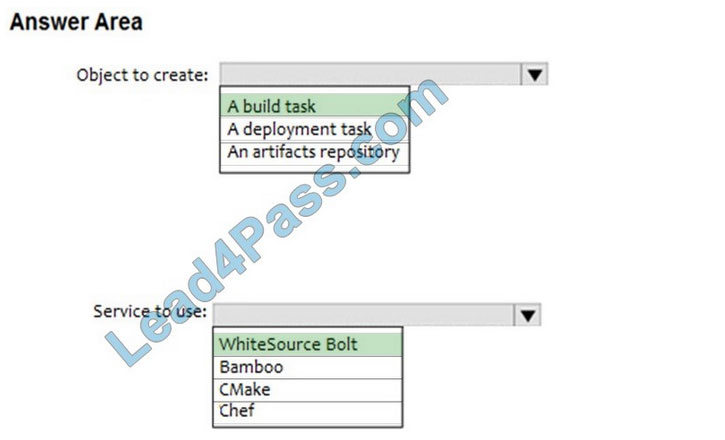
Explanation:
Box 1: A Build task Trigger a build You have a Java code provisioned by the Azure DevOps demo generator. You will use WhiteSource Bolt extension to check the vulnerable components present in this code.
1.
Go to Builds section under Pipelines tab, select the build definition WhiteSourceBolt and click on Queue to trigger a build.
2.
To view the build in progress status, click on ellipsis and select View build results.
Box 2: WhiteSource Bolt WhiteSource is the leader in continuous open source software security and compliance management. WhiteSource integrates into your build process, irrespective of your programming languages, build tools, or development environments. It works automatically, continuously, and silently in the background, checking the security, licensing, and quality of your open source components against WhiteSource constantly-updated definitive database of open source repositories.
References: https://www.azuredevopslabs.com/labs/vstsextend/whitesource/
Question 4:
HOTSPOT
You have a project in Azure DevOps.
You plan to create a build pipeline that will deploy resources by using Azure Resource Manager templates. The templates will reference secrets stored in Azure Key Vault.
You need to ensure that you can dynamically generate the resource ID of the key vault during template deployment.
What should you include in the template? To answer, select the appropriate options in the answer area.
NOTE: Each correct selection is worth one point.
Hot Area:

Correct Answer:
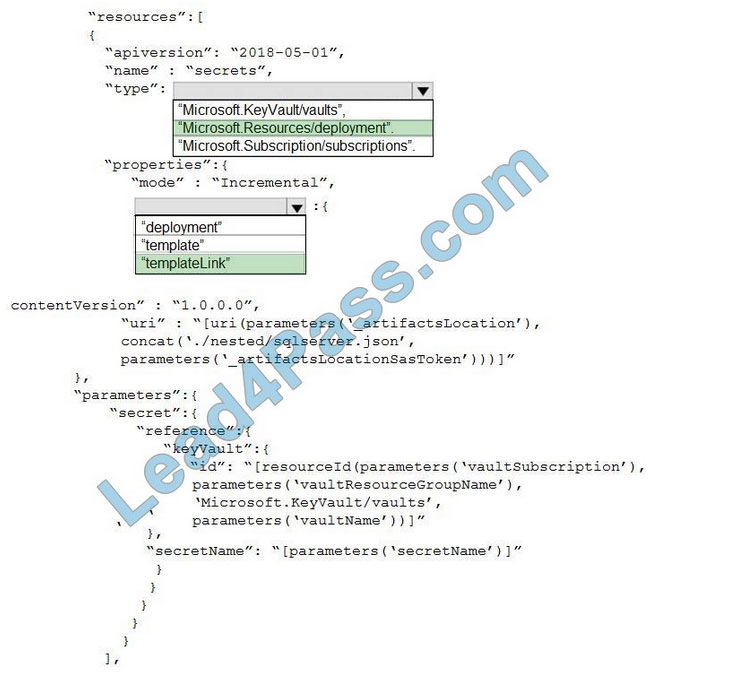
Box 1: “Microsoft.Resources/deployments”
Reference a secret with dynamic ID. You need to reference a key vault secret that varies based on the current deployment.
Example:
“resources”: [
{
“apiVersion”: “2018-05-01”,
“name”: “dynamicSecret”,
“type”: “Microsoft.Resources/deployments”,
“properties”: {
“mode”: “Incremental”,
“templateLink”: {
Box 2: “templateLink”
In your parent template, you add the linked template and pass in a parameter that contains the dynamically generated resource ID.
References: https://docs.microsoft.com/en-us/azure/azure-resource-manager/resource-manager-keyvault-parameter
Question 5:
HOTSPOT
Your company has an Azure subscription.
The company requires that all resource group in the subscription have a tag named organization set to a value of Contoso.
You need to implement a policy to meet the tagging requirement.
How should you complete the policy? To answer, select the appropriate options in the answer area.
NOTE: Each correct selection is worth one point.
Hot Area:

Correct Answer:
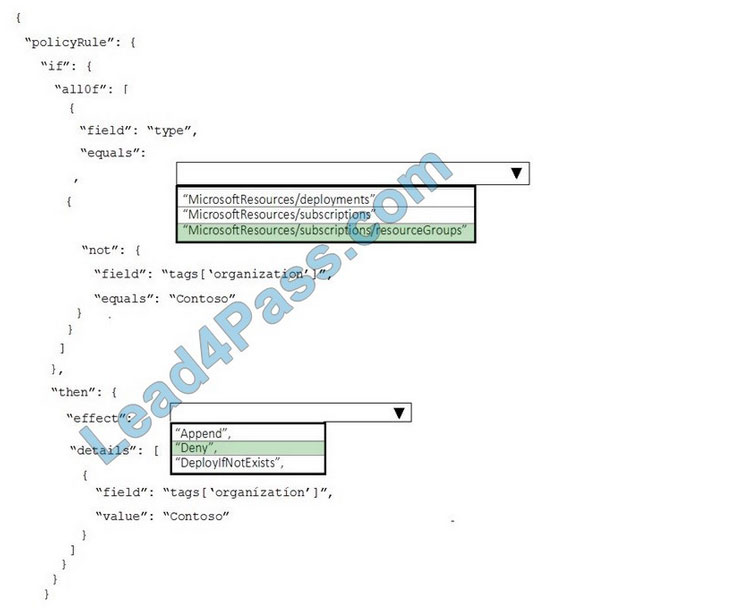
Box 1: ” Microsoft.Resources/subscriptions/resourceGroups”
Box 2: “Deny”,
Sample – Enforce tag and its value on resource groups
}, “policyRule”: { “if”: { “allOf”: [
{
“field”: “type”,
“equals”: “Microsoft.Resources/subscriptions/resourceGroups”
},
{
“not”: {
“field”: “[concat(\’tags[\’,parameters(\’tagName\’), \’]\’)]”,
“equals”: “[parameters(\’tagValue\’)]”
}
}
]
},
“then”: {
“effect”: “deny” } } } }
References: https://docs.microsoft.com/en-us/azure/governance/policy/samples/enforce-tag-on-resource-groups
Question 6:
HOTSPOT
You currently use JIRA, Jenkins, and Octopus as part of your DevOps processes.
You plan to use Azure DevOps to replace these tools.
Which Azure DevOps service should you use to replace each tool? To answer, select the appropriate options in the answer area.
NOTE: Each correct selection is worth one point.
Hot Area:

Correct Answer:
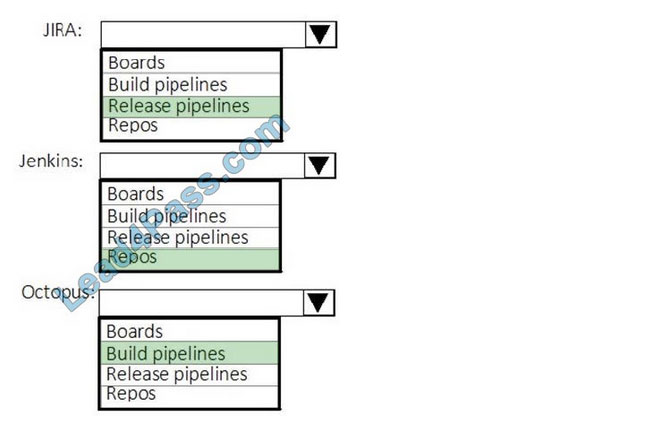
JIRA: Release pipelines Atlassian\’s Jira Software is a popular application that helps teams to plan, track, and manage software releases, whereas Octopus Deploy helps teams automate their development and operations processes in a fast, repeatable, and reliable manner. Together, they enable teams to get better end-to-end visibility into their software pipelines from idea to production.
Jenkins: Repos One way to integrate Jenkins with Azure Pipelines is to run CI jobs in Jenkins separately. This involves the configuration of a CI pipeline in Jenkins and a webhook in Azure DevOps that invokes the CI process when source code is pushed to a repository or a branch.
Octopus: Build pipelines
References: https://octopus.com/blog/octopus-jira-integration
https://www.azuredevopslabs.com/labs/vstsextend/jenkins/
Question 7:
HOTSPOT
Your company is creating a suite of three mobile applications.
You need to control access to the application builds. The solution must be managed at the organizational level.
What should you use? To answer, select the appropriate options in the answer area.
NOTE: Each correct selection is worth one point.
Hot Area:

Box 1: Microsoft Visual Studio App Center distribution Groups are used to control access to releases. A Distribution Group represents a set of users that can be managed jointly and can have common access to releases. Examples of Distribution Groups can be teams of users, like the QA Team or External Beta Testers, or can represent stages or rings of releases, such as Staging.
Box 2: Shared
Shared distribution groups are private or public distribution groups that are shared across multiple apps in a single organization. Shared distribution groups eliminate the need to replicate distribution groups across multiple apps.
Note: With the Deploy with App Center Task in Visual Studio Team Services, you can deploy your apps from Azure DevOps (formerly known as VSTS) to App Center. By deploying to App Center, you will be able to distribute your builds to
your users.
References: https://docs.microsoft.com/en-us/appcenter/distribution/groups
Question 8:
HOTSPOT
You need to deploy Azure Kubernetes Service (AKS) to host an application. The solution must meet the following requirements:
1.
Containers must only be published internally.
2.
AKS clusters must be able to create and manage containers in Azure.
What should you use for each requirement? To answer, select the appropriate options in the answer area.
NOTE: Each correct selection is worth one point.
Hot Area:

Box 1: Azure Container Registry Azure services like Azure Container Registry (ACR) and Azure Container Instances (ACI) can be used and connected from independent container orchestrators like Kubernetes (k8s). You can set up a custom ACR and connect it to an existing k8s cluster to ensure images will be pulled from the private container registry instead of the public docker hub.
Box 2: An Azure service principal When you\’re using Azure Container Registry (ACR) with Azure Kubernetes Service (AKS), an authentication mechanism needs to be established. You can set up AKS and ACR integration during the initial creation of your AKS cluster. To allow an AKS cluster to interact with ACR, an Azure Active Directory service principal is used.
References: https://thorsten-hans.com/how-to-use-private-azure-container-registry-with-kubernetes
https://docs.microsoft.com/en-us/azure/aks/cluster-container-registry-integration
Question 9:
HOTSPOT
You manage build and release pipelines by using Azure DevOps. Your entire managed environment resides in Azure.
You need to configure a service endpoint for accessing Azure Key Vault secrets. The solution must meet the following requirements:
1.
Ensure that the secrets are retrieved by Azure DevOps.
2.
Avoid persisting credentials and tokens in Azure DevOps.
How should you configure the service endpoint? To answer, select the appropriate options in the answer area.
NOTE: Each correct selection is worth one point.
Hot Area:

Box 1: Azure Pipelines service connection
Box 2: Managed Service Identity Authentication The managed identities for Azure resources feature in Azure Active Directory (Azure AD) provides Azure services with an automatically managed identity in Azure AD. You can use the identity to authenticate to any service that supports Azure AD authentication, including Key Vault, without any credentials in your code.
Reference: https://docs.microsoft.com/en-us/azure/devops/pipelines/tasks/deploy/azure-key-vault
https://docs.microsoft.com/en-us/azure/active-directory/managed-identities-azure-resources/overview
Question 10:
HOTSPOT
You plan to create alerts that will be triggered based on the page load performance of a home page.
You have the Application Insights log query shown in the following exhibit.

Use the drop-down menus to select the answer choice that completes each statement based on the information presented in the graphic.
NOTE: Each correct selection is worth one point.
Hot Area:
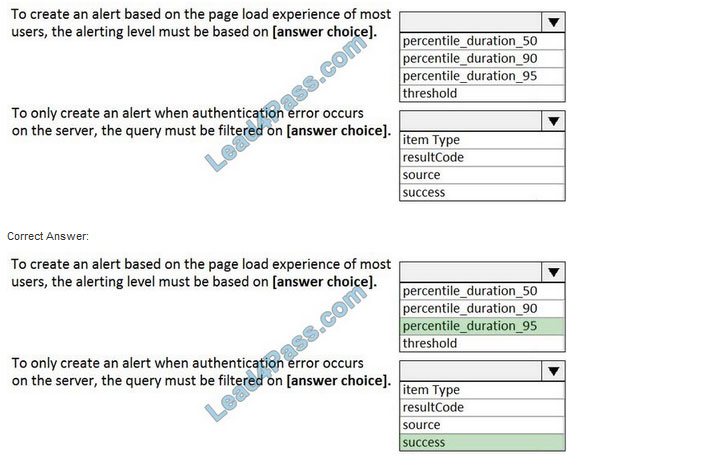
Box 1: percentile_duration_95
Box 2: success
For example –
requests
| project name, url, success
| where success == “False”
This will return all the failed requests in my App Insights within the specified time range.
Reference:
https://devblogs.microsoft.com/premier-developer/alerts-based-on-analytics-query-using-custom-log-search/
Question 11:
HOTSPOT
Your company uses Git as a source code control system for a complex app named App1.
You plan to add a new functionality to App1.
You need to design a branching model for the new functionality.
Which branch lifetime and branch time should you use in the branching model? To answer, select the appropriate options in the answer area.
NOTE: Each correct selection is worth one point.
Hot Area:

Branch lifetime: Short-lived
Branch Type: Feature Feature branches are used when developing a new feature or enhancement which has the potential of a development lifespan longer than a single deployment. When starting development, the deployment in which this feature will be released may not be known. No matter when the feature branch will be finished, it will always be merged back into the master branch.
References: https://gist.github.com/digitaljhelms/4287848
Question 12:
HOTSPOT
You have a project in Azure DevOps that has three teams as shown in the Teams exhibit. (Click the Teams tab.)

You create a new dashboard named Dash1.
You configure the dashboard permissions for the Control project as shown in the Permissions exhibit. (Click the Permissions tab.)
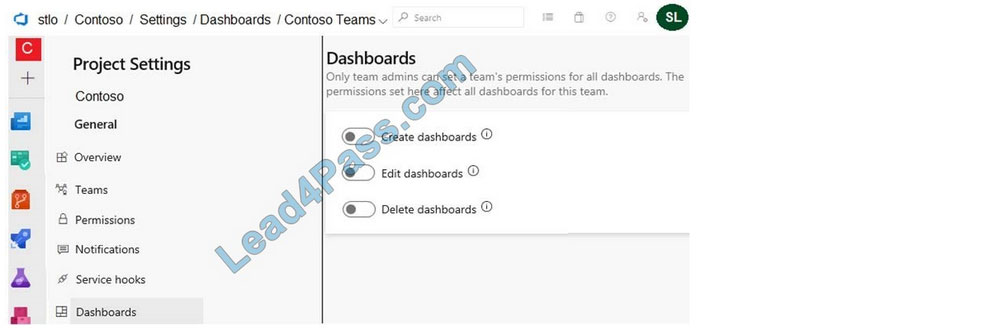
All other permissions have the default values set.
For each of the following statements, select Yes if the statement is true. Otherwise, select No.
NOTE: Each correct selection is worth one point.
Hot Area:
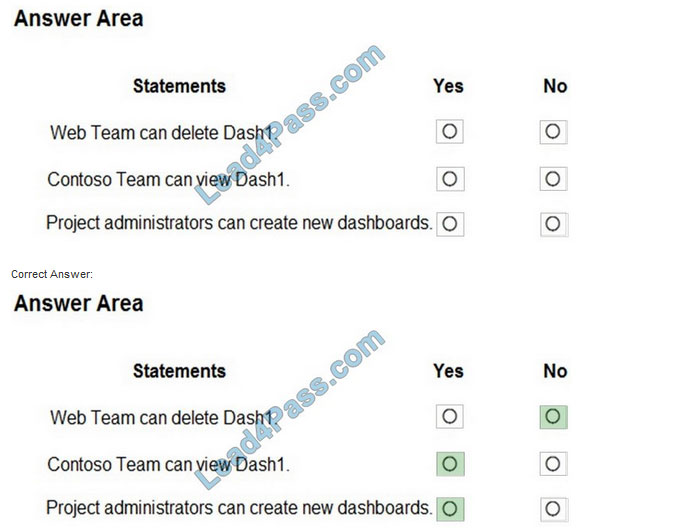
Reference: https://docs.microsoft.com/en-us/azure/devops/report/dashboards/charts-dashboard-permissions-access
Question 13:
HOTSPOT
You have the Azure DevOps pipeline shown in the following exhibit.

Use the drop-down menus to select the answer choice that completes each statement based on the information presented in the graphic.
Hot Area:

Question 14:
HOTSPOT
You have a project in Azure DevOps named Contoso App that contains pipelines in Azure Pipelines for GitHub repositories. You need to ensure that developers receive Microsoft Teams notifications when there are failures in a pipeline of
Contoso App. What should you run in Teams?
To answer, select the appropriate options in the answer are NOTE: Each correct selection is worth one point.
Hot Area:
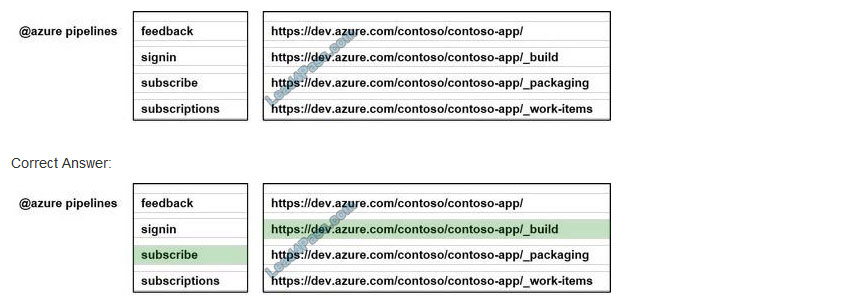
Question 15:
HOTSPOT
Your company uses GitHub for source control. GitHub repositories store source code and store process documentation. The process documentation is saved as Microsoft Word documents that contain simple flow charts stored as .bmp files.
You need to optimize the integration and versioning of the process documentation and the flow charts. The solution must meet the following requirements:
1.
Store documents as plain text.
2.
Minimize the number of files that must be maintained.
3.
Simplify the modification, merging, and reuse of flow charts.
4.
Simplify the modification, merging, and reuse of documents.
What should you include in the solution? To answer, select the appropriate options in the answer area. NOTE: Each correct selection is worth one point.
Hot Area:
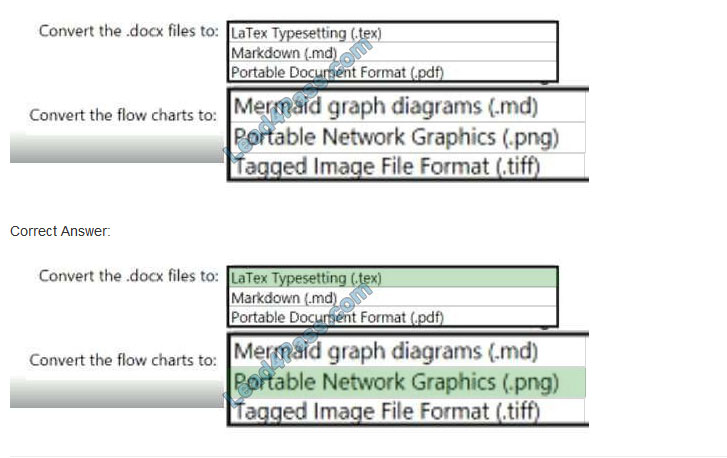
12 Microsoft AZ-400 Free Dumps to help you verify real Microsoft AZ-400 dumps: https://www.leads4pass.com/az-400.html. 370 Dump exam questions to help you easily prepare for the Designing and Implementing Microsoft DevOps Solutions exam.